Entrepreneurial Strategies and Analysis for Prezzo Restaurant Report
VerifiedAdded on 2020/12/18
|13
|3885
|94
Report
AI Summary
This report offers a comprehensive analysis of Prezzo Restaurant's entrepreneurial strategy. It begins with a company overview, followed by a discussion of entrepreneurial strategies including Porter's Five Forces, BCG Matrix, and McKinsey 7S Framework. The report delves into SWOT, TOWS, and PESTLE analyses to assess the internal and external environments impacting Prezzo. It also establishes SMART objectives and proposes strategic implementations and recommendations for the company's future. The analysis covers the restaurant's strengths, weaknesses, opportunities, and threats within the context of the food sector in the UK and Ireland. The report uses various analytical frameworks to evaluate the competitive landscape, internal capabilities, and external factors affecting the restaurant's performance and strategic direction, culminating in actionable recommendations.
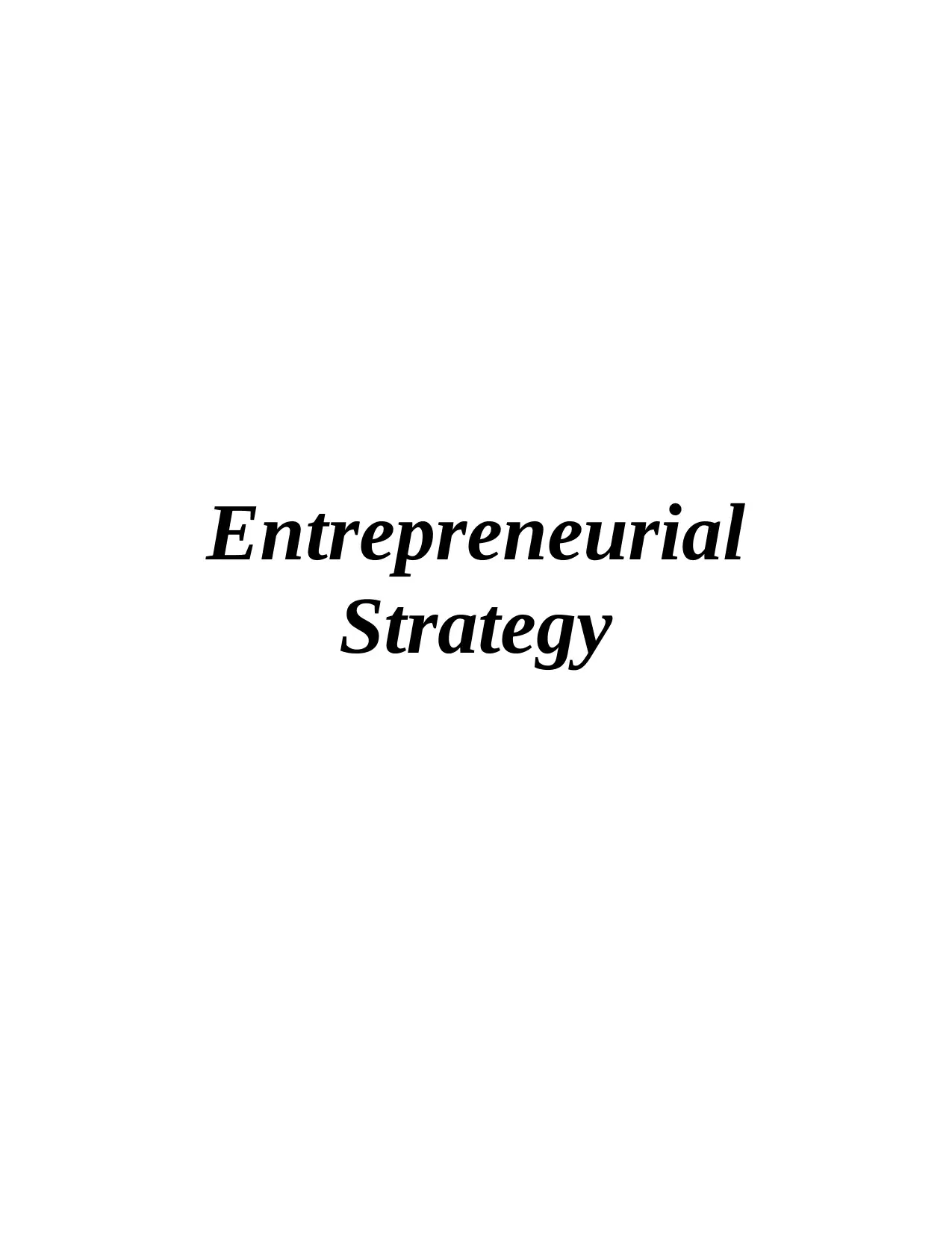
Entrepreneurial
Strategy
Strategy
Paraphrase This Document
Need a fresh take? Get an instant paraphrase of this document with our AI Paraphraser
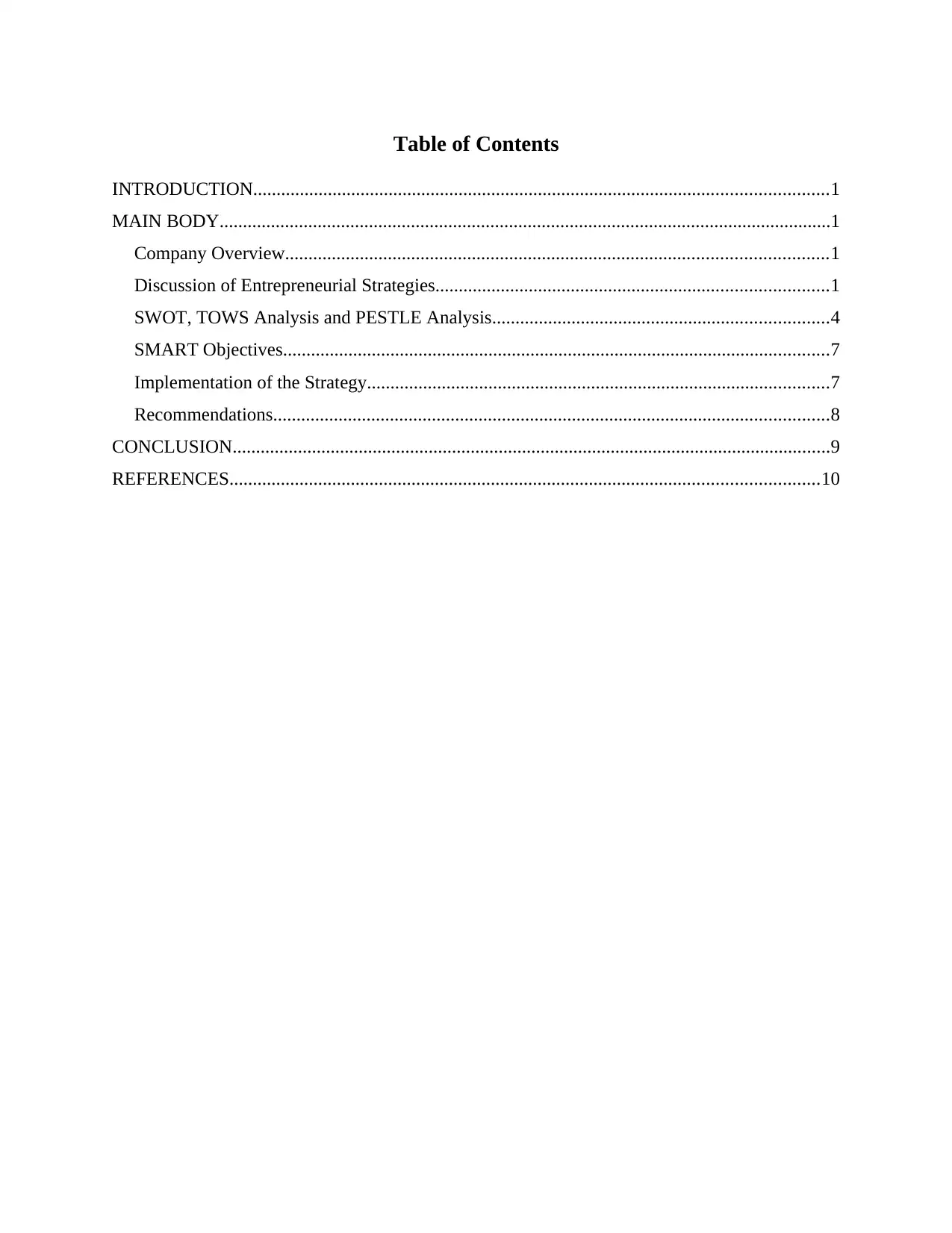
Table of Contents
INTRODUCTION...........................................................................................................................1
MAIN BODY...................................................................................................................................1
Company Overview....................................................................................................................1
Discussion of Entrepreneurial Strategies....................................................................................1
SWOT, TOWS Analysis and PESTLE Analysis........................................................................4
SMART Objectives.....................................................................................................................7
Implementation of the Strategy...................................................................................................7
Recommendations.......................................................................................................................8
CONCLUSION................................................................................................................................9
REFERENCES..............................................................................................................................10
INTRODUCTION...........................................................................................................................1
MAIN BODY...................................................................................................................................1
Company Overview....................................................................................................................1
Discussion of Entrepreneurial Strategies....................................................................................1
SWOT, TOWS Analysis and PESTLE Analysis........................................................................4
SMART Objectives.....................................................................................................................7
Implementation of the Strategy...................................................................................................7
Recommendations.......................................................................................................................8
CONCLUSION................................................................................................................................9
REFERENCES..............................................................................................................................10

⊘ This is a preview!⊘
Do you want full access?
Subscribe today to unlock all pages.

Trusted by 1+ million students worldwide
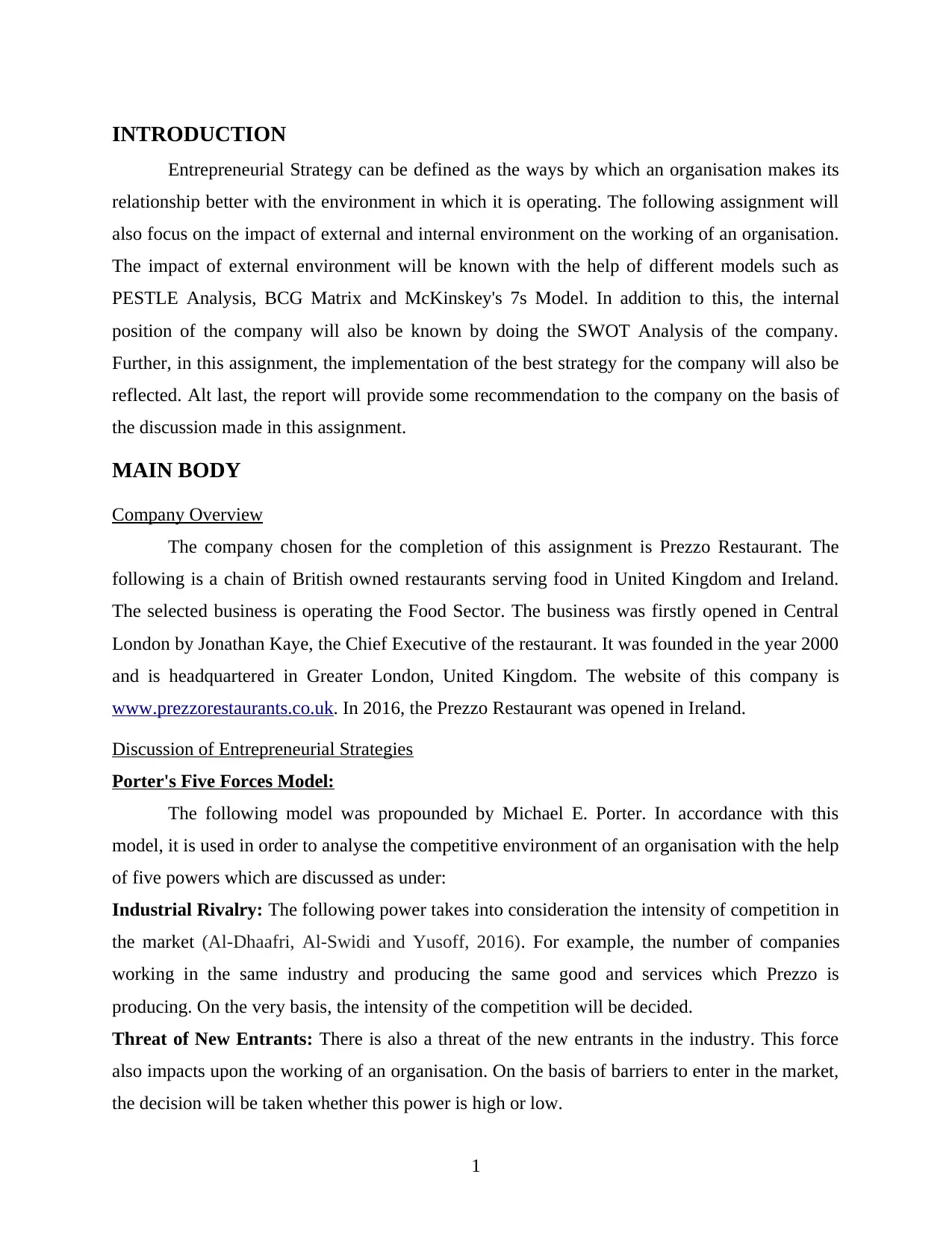
INTRODUCTION
Entrepreneurial Strategy can be defined as the ways by which an organisation makes its
relationship better with the environment in which it is operating. The following assignment will
also focus on the impact of external and internal environment on the working of an organisation.
The impact of external environment will be known with the help of different models such as
PESTLE Analysis, BCG Matrix and McKinskey's 7s Model. In addition to this, the internal
position of the company will also be known by doing the SWOT Analysis of the company.
Further, in this assignment, the implementation of the best strategy for the company will also be
reflected. Alt last, the report will provide some recommendation to the company on the basis of
the discussion made in this assignment.
MAIN BODY
Company Overview
The company chosen for the completion of this assignment is Prezzo Restaurant. The
following is a chain of British owned restaurants serving food in United Kingdom and Ireland.
The selected business is operating the Food Sector. The business was firstly opened in Central
London by Jonathan Kaye, the Chief Executive of the restaurant. It was founded in the year 2000
and is headquartered in Greater London, United Kingdom. The website of this company is
www.prezzorestaurants.co.uk. In 2016, the Prezzo Restaurant was opened in Ireland.
Discussion of Entrepreneurial Strategies
Porter's Five Forces Model:
The following model was propounded by Michael E. Porter. In accordance with this
model, it is used in order to analyse the competitive environment of an organisation with the help
of five powers which are discussed as under:
Industrial Rivalry: The following power takes into consideration the intensity of competition in
the market (Al-Dhaafri, Al-Swidi and Yusoff, 2016). For example, the number of companies
working in the same industry and producing the same good and services which Prezzo is
producing. On the very basis, the intensity of the competition will be decided.
Threat of New Entrants: There is also a threat of the new entrants in the industry. This force
also impacts upon the working of an organisation. On the basis of barriers to enter in the market,
the decision will be taken whether this power is high or low.
1
Entrepreneurial Strategy can be defined as the ways by which an organisation makes its
relationship better with the environment in which it is operating. The following assignment will
also focus on the impact of external and internal environment on the working of an organisation.
The impact of external environment will be known with the help of different models such as
PESTLE Analysis, BCG Matrix and McKinskey's 7s Model. In addition to this, the internal
position of the company will also be known by doing the SWOT Analysis of the company.
Further, in this assignment, the implementation of the best strategy for the company will also be
reflected. Alt last, the report will provide some recommendation to the company on the basis of
the discussion made in this assignment.
MAIN BODY
Company Overview
The company chosen for the completion of this assignment is Prezzo Restaurant. The
following is a chain of British owned restaurants serving food in United Kingdom and Ireland.
The selected business is operating the Food Sector. The business was firstly opened in Central
London by Jonathan Kaye, the Chief Executive of the restaurant. It was founded in the year 2000
and is headquartered in Greater London, United Kingdom. The website of this company is
www.prezzorestaurants.co.uk. In 2016, the Prezzo Restaurant was opened in Ireland.
Discussion of Entrepreneurial Strategies
Porter's Five Forces Model:
The following model was propounded by Michael E. Porter. In accordance with this
model, it is used in order to analyse the competitive environment of an organisation with the help
of five powers which are discussed as under:
Industrial Rivalry: The following power takes into consideration the intensity of competition in
the market (Al-Dhaafri, Al-Swidi and Yusoff, 2016). For example, the number of companies
working in the same industry and producing the same good and services which Prezzo is
producing. On the very basis, the intensity of the competition will be decided.
Threat of New Entrants: There is also a threat of the new entrants in the industry. This force
also impacts upon the working of an organisation. On the basis of barriers to enter in the market,
the decision will be taken whether this power is high or low.
1
Paraphrase This Document
Need a fresh take? Get an instant paraphrase of this document with our AI Paraphraser
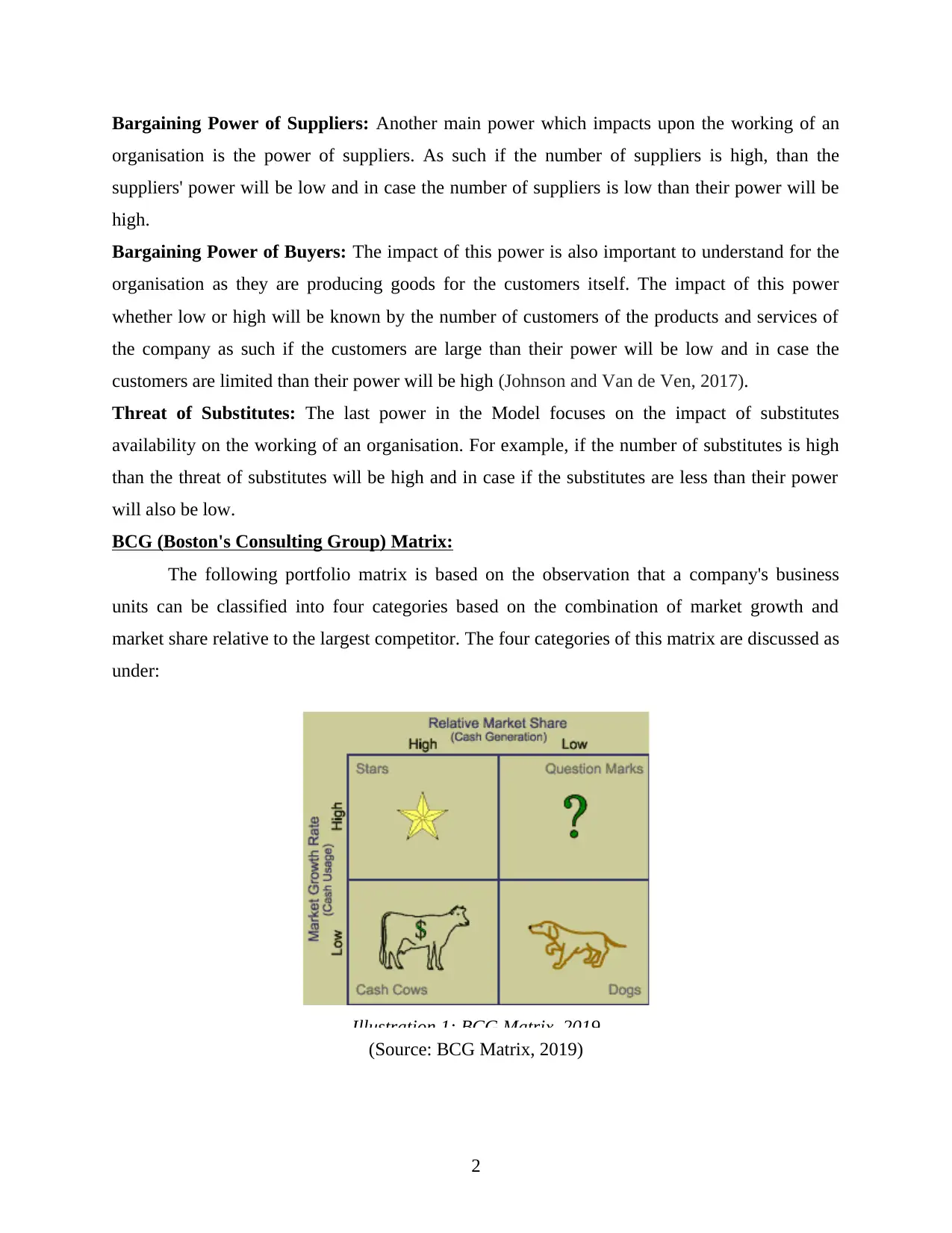
Bargaining Power of Suppliers: Another main power which impacts upon the working of an
organisation is the power of suppliers. As such if the number of suppliers is high, than the
suppliers' power will be low and in case the number of suppliers is low than their power will be
high.
Bargaining Power of Buyers: The impact of this power is also important to understand for the
organisation as they are producing goods for the customers itself. The impact of this power
whether low or high will be known by the number of customers of the products and services of
the company as such if the customers are large than their power will be low and in case the
customers are limited than their power will be high (Johnson and Van de Ven, 2017).
Threat of Substitutes: The last power in the Model focuses on the impact of substitutes
availability on the working of an organisation. For example, if the number of substitutes is high
than the threat of substitutes will be high and in case if the substitutes are less than their power
will also be low.
BCG (Boston's Consulting Group) Matrix:
The following portfolio matrix is based on the observation that a company's business
units can be classified into four categories based on the combination of market growth and
market share relative to the largest competitor. The four categories of this matrix are discussed as
under:
(Source: BCG Matrix, 2019)
2
Illustration 1: BCG Matrix, 2019
organisation is the power of suppliers. As such if the number of suppliers is high, than the
suppliers' power will be low and in case the number of suppliers is low than their power will be
high.
Bargaining Power of Buyers: The impact of this power is also important to understand for the
organisation as they are producing goods for the customers itself. The impact of this power
whether low or high will be known by the number of customers of the products and services of
the company as such if the customers are large than their power will be low and in case the
customers are limited than their power will be high (Johnson and Van de Ven, 2017).
Threat of Substitutes: The last power in the Model focuses on the impact of substitutes
availability on the working of an organisation. For example, if the number of substitutes is high
than the threat of substitutes will be high and in case if the substitutes are less than their power
will also be low.
BCG (Boston's Consulting Group) Matrix:
The following portfolio matrix is based on the observation that a company's business
units can be classified into four categories based on the combination of market growth and
market share relative to the largest competitor. The four categories of this matrix are discussed as
under:
(Source: BCG Matrix, 2019)
2
Illustration 1: BCG Matrix, 2019
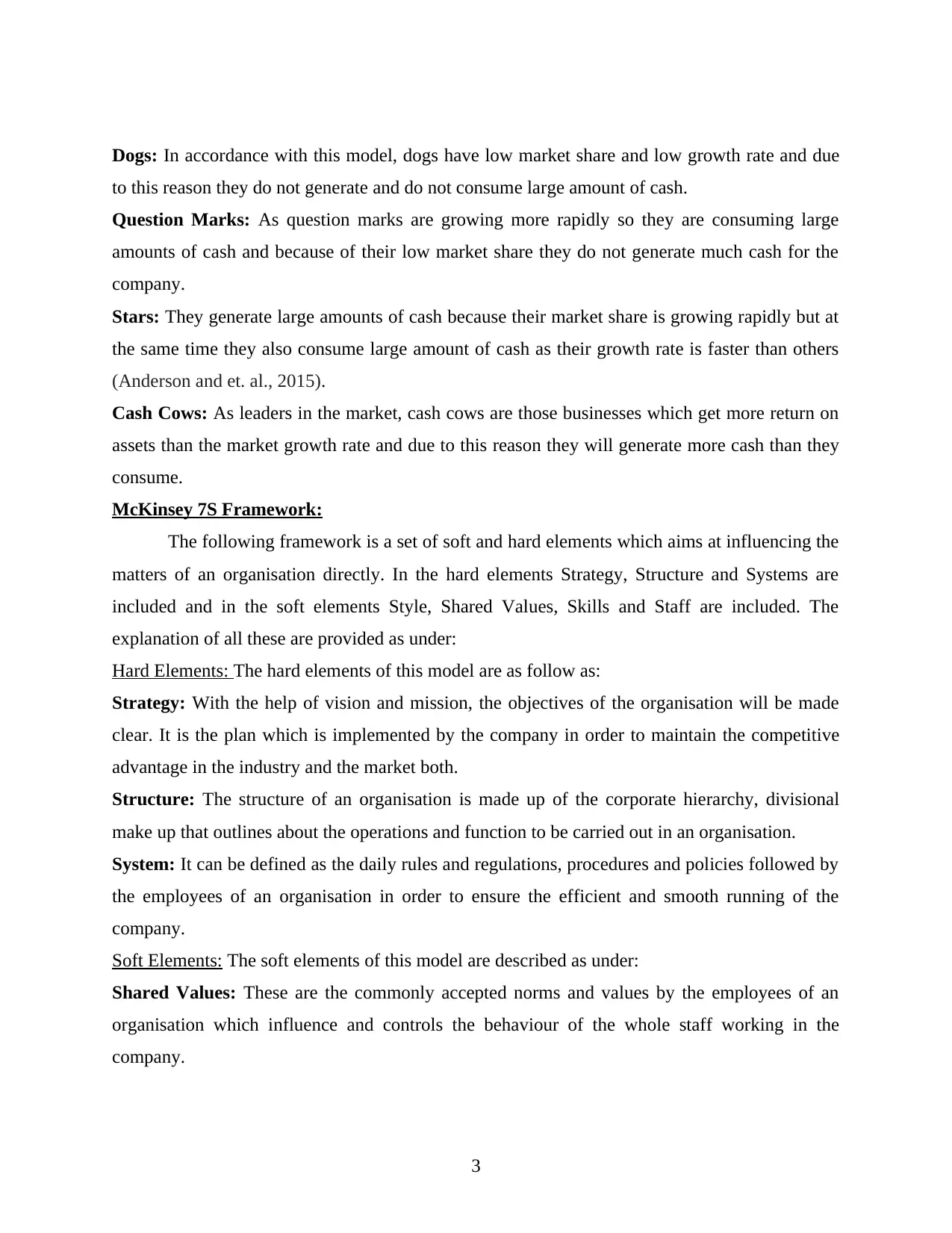
Dogs: In accordance with this model, dogs have low market share and low growth rate and due
to this reason they do not generate and do not consume large amount of cash.
Question Marks: As question marks are growing more rapidly so they are consuming large
amounts of cash and because of their low market share they do not generate much cash for the
company.
Stars: They generate large amounts of cash because their market share is growing rapidly but at
the same time they also consume large amount of cash as their growth rate is faster than others
(Anderson and et. al., 2015).
Cash Cows: As leaders in the market, cash cows are those businesses which get more return on
assets than the market growth rate and due to this reason they will generate more cash than they
consume.
McKinsey 7S Framework:
The following framework is a set of soft and hard elements which aims at influencing the
matters of an organisation directly. In the hard elements Strategy, Structure and Systems are
included and in the soft elements Style, Shared Values, Skills and Staff are included. The
explanation of all these are provided as under:
Hard Elements: The hard elements of this model are as follow as:
Strategy: With the help of vision and mission, the objectives of the organisation will be made
clear. It is the plan which is implemented by the company in order to maintain the competitive
advantage in the industry and the market both.
Structure: The structure of an organisation is made up of the corporate hierarchy, divisional
make up that outlines about the operations and function to be carried out in an organisation.
System: It can be defined as the daily rules and regulations, procedures and policies followed by
the employees of an organisation in order to ensure the efficient and smooth running of the
company.
Soft Elements: The soft elements of this model are described as under:
Shared Values: These are the commonly accepted norms and values by the employees of an
organisation which influence and controls the behaviour of the whole staff working in the
company.
3
to this reason they do not generate and do not consume large amount of cash.
Question Marks: As question marks are growing more rapidly so they are consuming large
amounts of cash and because of their low market share they do not generate much cash for the
company.
Stars: They generate large amounts of cash because their market share is growing rapidly but at
the same time they also consume large amount of cash as their growth rate is faster than others
(Anderson and et. al., 2015).
Cash Cows: As leaders in the market, cash cows are those businesses which get more return on
assets than the market growth rate and due to this reason they will generate more cash than they
consume.
McKinsey 7S Framework:
The following framework is a set of soft and hard elements which aims at influencing the
matters of an organisation directly. In the hard elements Strategy, Structure and Systems are
included and in the soft elements Style, Shared Values, Skills and Staff are included. The
explanation of all these are provided as under:
Hard Elements: The hard elements of this model are as follow as:
Strategy: With the help of vision and mission, the objectives of the organisation will be made
clear. It is the plan which is implemented by the company in order to maintain the competitive
advantage in the industry and the market both.
Structure: The structure of an organisation is made up of the corporate hierarchy, divisional
make up that outlines about the operations and function to be carried out in an organisation.
System: It can be defined as the daily rules and regulations, procedures and policies followed by
the employees of an organisation in order to ensure the efficient and smooth running of the
company.
Soft Elements: The soft elements of this model are described as under:
Shared Values: These are the commonly accepted norms and values by the employees of an
organisation which influence and controls the behaviour of the whole staff working in the
company.
3
⊘ This is a preview!⊘
Do you want full access?
Subscribe today to unlock all pages.

Trusted by 1+ million students worldwide
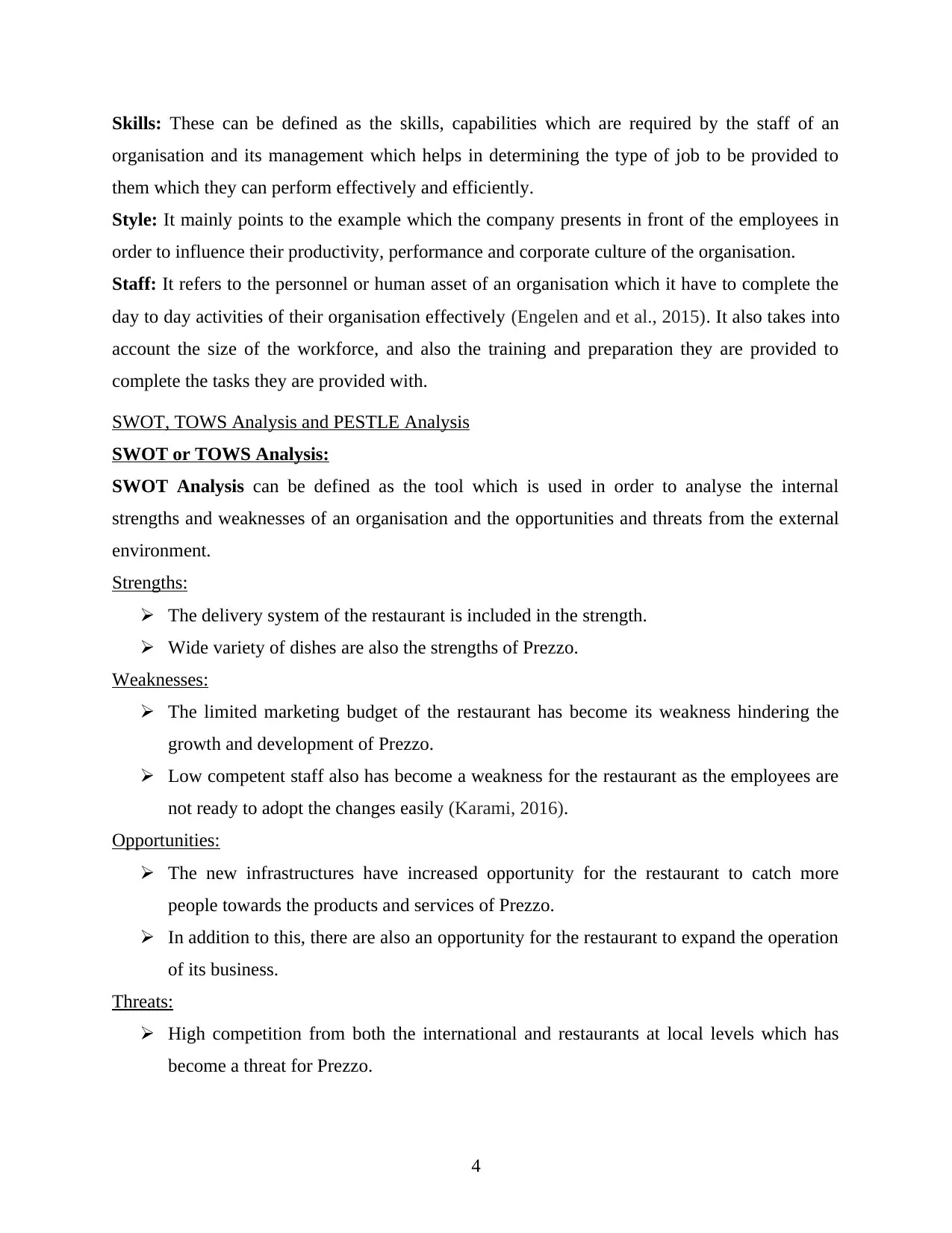
Skills: These can be defined as the skills, capabilities which are required by the staff of an
organisation and its management which helps in determining the type of job to be provided to
them which they can perform effectively and efficiently.
Style: It mainly points to the example which the company presents in front of the employees in
order to influence their productivity, performance and corporate culture of the organisation.
Staff: It refers to the personnel or human asset of an organisation which it have to complete the
day to day activities of their organisation effectively (Engelen and et al., 2015). It also takes into
account the size of the workforce, and also the training and preparation they are provided to
complete the tasks they are provided with.
SWOT, TOWS Analysis and PESTLE Analysis
SWOT or TOWS Analysis:
SWOT Analysis can be defined as the tool which is used in order to analyse the internal
strengths and weaknesses of an organisation and the opportunities and threats from the external
environment.
Strengths:
The delivery system of the restaurant is included in the strength.
Wide variety of dishes are also the strengths of Prezzo.
Weaknesses:
The limited marketing budget of the restaurant has become its weakness hindering the
growth and development of Prezzo.
Low competent staff also has become a weakness for the restaurant as the employees are
not ready to adopt the changes easily (Karami, 2016).
Opportunities:
The new infrastructures have increased opportunity for the restaurant to catch more
people towards the products and services of Prezzo.
In addition to this, there are also an opportunity for the restaurant to expand the operation
of its business.
Threats:
High competition from both the international and restaurants at local levels which has
become a threat for Prezzo.
4
organisation and its management which helps in determining the type of job to be provided to
them which they can perform effectively and efficiently.
Style: It mainly points to the example which the company presents in front of the employees in
order to influence their productivity, performance and corporate culture of the organisation.
Staff: It refers to the personnel or human asset of an organisation which it have to complete the
day to day activities of their organisation effectively (Engelen and et al., 2015). It also takes into
account the size of the workforce, and also the training and preparation they are provided to
complete the tasks they are provided with.
SWOT, TOWS Analysis and PESTLE Analysis
SWOT or TOWS Analysis:
SWOT Analysis can be defined as the tool which is used in order to analyse the internal
strengths and weaknesses of an organisation and the opportunities and threats from the external
environment.
Strengths:
The delivery system of the restaurant is included in the strength.
Wide variety of dishes are also the strengths of Prezzo.
Weaknesses:
The limited marketing budget of the restaurant has become its weakness hindering the
growth and development of Prezzo.
Low competent staff also has become a weakness for the restaurant as the employees are
not ready to adopt the changes easily (Karami, 2016).
Opportunities:
The new infrastructures have increased opportunity for the restaurant to catch more
people towards the products and services of Prezzo.
In addition to this, there are also an opportunity for the restaurant to expand the operation
of its business.
Threats:
High competition from both the international and restaurants at local levels which has
become a threat for Prezzo.
4
Paraphrase This Document
Need a fresh take? Get an instant paraphrase of this document with our AI Paraphraser
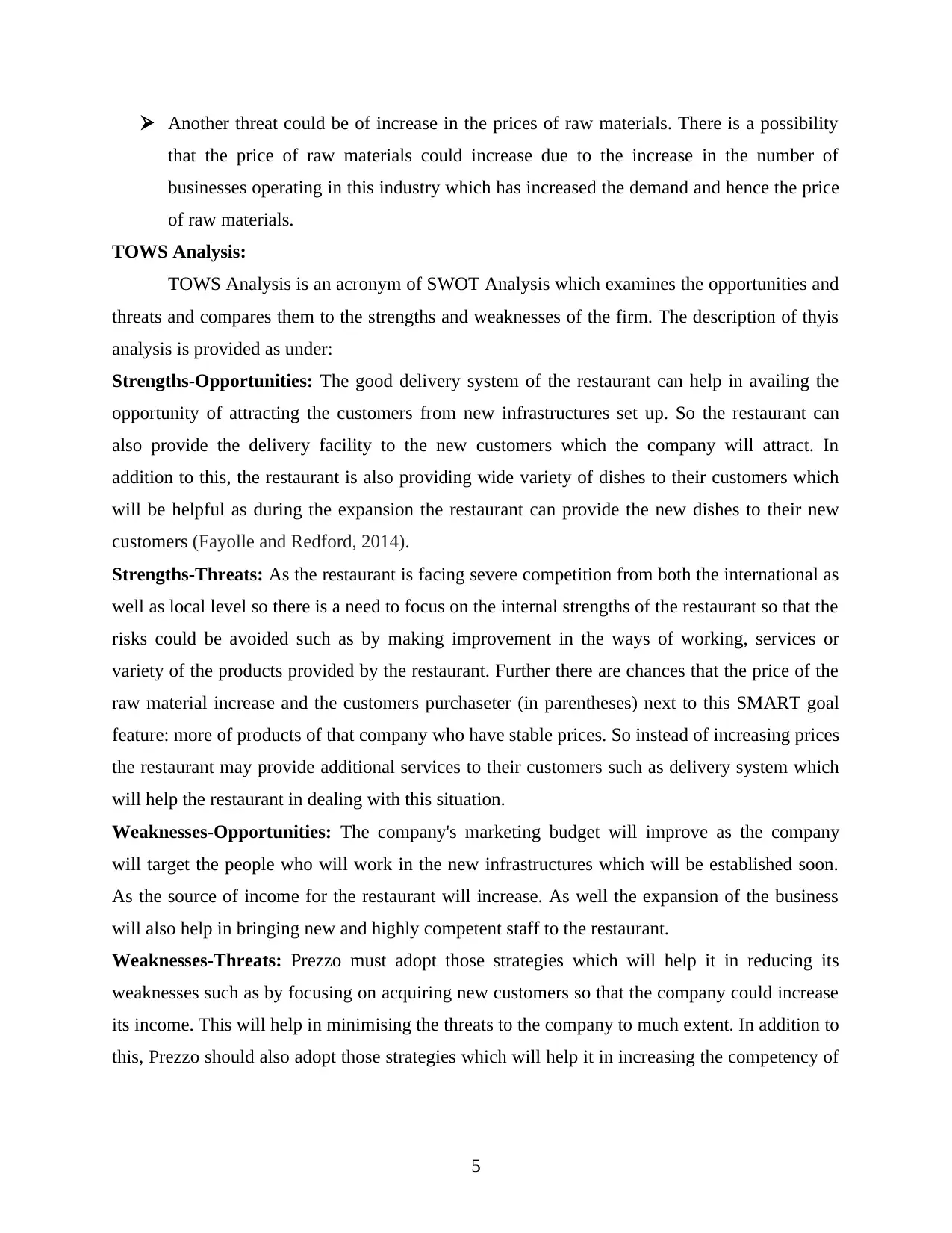
Another threat could be of increase in the prices of raw materials. There is a possibility
that the price of raw materials could increase due to the increase in the number of
businesses operating in this industry which has increased the demand and hence the price
of raw materials.
TOWS Analysis:
TOWS Analysis is an acronym of SWOT Analysis which examines the opportunities and
threats and compares them to the strengths and weaknesses of the firm. The description of thyis
analysis is provided as under:
Strengths-Opportunities: The good delivery system of the restaurant can help in availing the
opportunity of attracting the customers from new infrastructures set up. So the restaurant can
also provide the delivery facility to the new customers which the company will attract. In
addition to this, the restaurant is also providing wide variety of dishes to their customers which
will be helpful as during the expansion the restaurant can provide the new dishes to their new
customers (Fayolle and Redford, 2014).
Strengths-Threats: As the restaurant is facing severe competition from both the international as
well as local level so there is a need to focus on the internal strengths of the restaurant so that the
risks could be avoided such as by making improvement in the ways of working, services or
variety of the products provided by the restaurant. Further there are chances that the price of the
raw material increase and the customers purchaseter (in parentheses) next to this SMART goal
feature: more of products of that company who have stable prices. So instead of increasing prices
the restaurant may provide additional services to their customers such as delivery system which
will help the restaurant in dealing with this situation.
Weaknesses-Opportunities: The company's marketing budget will improve as the company
will target the people who will work in the new infrastructures which will be established soon.
As the source of income for the restaurant will increase. As well the expansion of the business
will also help in bringing new and highly competent staff to the restaurant.
Weaknesses-Threats: Prezzo must adopt those strategies which will help it in reducing its
weaknesses such as by focusing on acquiring new customers so that the company could increase
its income. This will help in minimising the threats to the company to much extent. In addition to
this, Prezzo should also adopt those strategies which will help it in increasing the competency of
5
that the price of raw materials could increase due to the increase in the number of
businesses operating in this industry which has increased the demand and hence the price
of raw materials.
TOWS Analysis:
TOWS Analysis is an acronym of SWOT Analysis which examines the opportunities and
threats and compares them to the strengths and weaknesses of the firm. The description of thyis
analysis is provided as under:
Strengths-Opportunities: The good delivery system of the restaurant can help in availing the
opportunity of attracting the customers from new infrastructures set up. So the restaurant can
also provide the delivery facility to the new customers which the company will attract. In
addition to this, the restaurant is also providing wide variety of dishes to their customers which
will be helpful as during the expansion the restaurant can provide the new dishes to their new
customers (Fayolle and Redford, 2014).
Strengths-Threats: As the restaurant is facing severe competition from both the international as
well as local level so there is a need to focus on the internal strengths of the restaurant so that the
risks could be avoided such as by making improvement in the ways of working, services or
variety of the products provided by the restaurant. Further there are chances that the price of the
raw material increase and the customers purchaseter (in parentheses) next to this SMART goal
feature: more of products of that company who have stable prices. So instead of increasing prices
the restaurant may provide additional services to their customers such as delivery system which
will help the restaurant in dealing with this situation.
Weaknesses-Opportunities: The company's marketing budget will improve as the company
will target the people who will work in the new infrastructures which will be established soon.
As the source of income for the restaurant will increase. As well the expansion of the business
will also help in bringing new and highly competent staff to the restaurant.
Weaknesses-Threats: Prezzo must adopt those strategies which will help it in reducing its
weaknesses such as by focusing on acquiring new customers so that the company could increase
its income. This will help in minimising the threats to the company to much extent. In addition to
this, Prezzo should also adopt those strategies which will help it in increasing the competency of
5
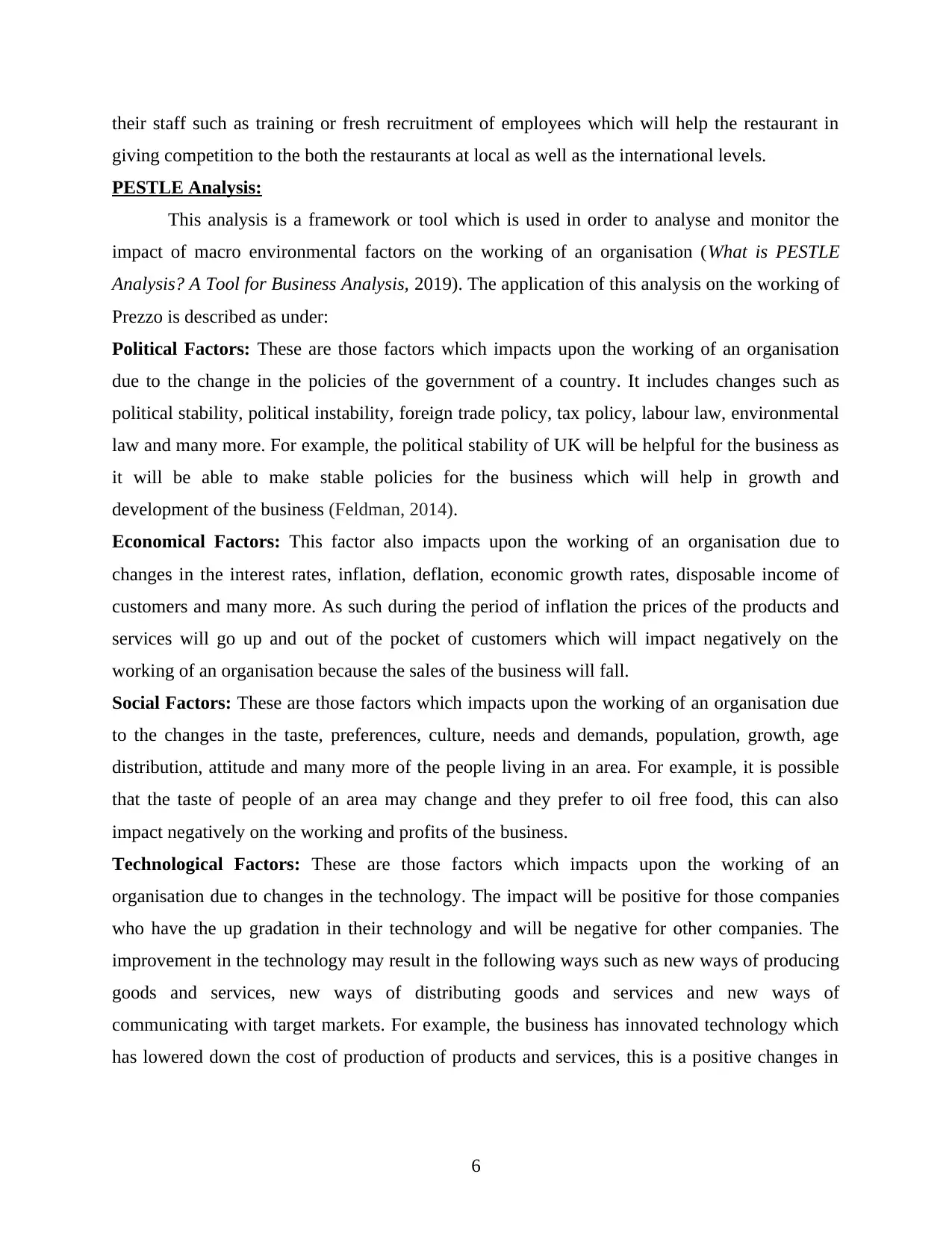
their staff such as training or fresh recruitment of employees which will help the restaurant in
giving competition to the both the restaurants at local as well as the international levels.
PESTLE Analysis:
This analysis is a framework or tool which is used in order to analyse and monitor the
impact of macro environmental factors on the working of an organisation (What is PESTLE
Analysis? A Tool for Business Analysis, 2019). The application of this analysis on the working of
Prezzo is described as under:
Political Factors: These are those factors which impacts upon the working of an organisation
due to the change in the policies of the government of a country. It includes changes such as
political stability, political instability, foreign trade policy, tax policy, labour law, environmental
law and many more. For example, the political stability of UK will be helpful for the business as
it will be able to make stable policies for the business which will help in growth and
development of the business (Feldman, 2014).
Economical Factors: This factor also impacts upon the working of an organisation due to
changes in the interest rates, inflation, deflation, economic growth rates, disposable income of
customers and many more. As such during the period of inflation the prices of the products and
services will go up and out of the pocket of customers which will impact negatively on the
working of an organisation because the sales of the business will fall.
Social Factors: These are those factors which impacts upon the working of an organisation due
to the changes in the taste, preferences, culture, needs and demands, population, growth, age
distribution, attitude and many more of the people living in an area. For example, it is possible
that the taste of people of an area may change and they prefer to oil free food, this can also
impact negatively on the working and profits of the business.
Technological Factors: These are those factors which impacts upon the working of an
organisation due to changes in the technology. The impact will be positive for those companies
who have the up gradation in their technology and will be negative for other companies. The
improvement in the technology may result in the following ways such as new ways of producing
goods and services, new ways of distributing goods and services and new ways of
communicating with target markets. For example, the business has innovated technology which
has lowered down the cost of production of products and services, this is a positive changes in
6
giving competition to the both the restaurants at local as well as the international levels.
PESTLE Analysis:
This analysis is a framework or tool which is used in order to analyse and monitor the
impact of macro environmental factors on the working of an organisation (What is PESTLE
Analysis? A Tool for Business Analysis, 2019). The application of this analysis on the working of
Prezzo is described as under:
Political Factors: These are those factors which impacts upon the working of an organisation
due to the change in the policies of the government of a country. It includes changes such as
political stability, political instability, foreign trade policy, tax policy, labour law, environmental
law and many more. For example, the political stability of UK will be helpful for the business as
it will be able to make stable policies for the business which will help in growth and
development of the business (Feldman, 2014).
Economical Factors: This factor also impacts upon the working of an organisation due to
changes in the interest rates, inflation, deflation, economic growth rates, disposable income of
customers and many more. As such during the period of inflation the prices of the products and
services will go up and out of the pocket of customers which will impact negatively on the
working of an organisation because the sales of the business will fall.
Social Factors: These are those factors which impacts upon the working of an organisation due
to the changes in the taste, preferences, culture, needs and demands, population, growth, age
distribution, attitude and many more of the people living in an area. For example, it is possible
that the taste of people of an area may change and they prefer to oil free food, this can also
impact negatively on the working and profits of the business.
Technological Factors: These are those factors which impacts upon the working of an
organisation due to changes in the technology. The impact will be positive for those companies
who have the up gradation in their technology and will be negative for other companies. The
improvement in the technology may result in the following ways such as new ways of producing
goods and services, new ways of distributing goods and services and new ways of
communicating with target markets. For example, the business has innovated technology which
has lowered down the cost of production of products and services, this is a positive changes in
6
⊘ This is a preview!⊘
Do you want full access?
Subscribe today to unlock all pages.

Trusted by 1+ million students worldwide
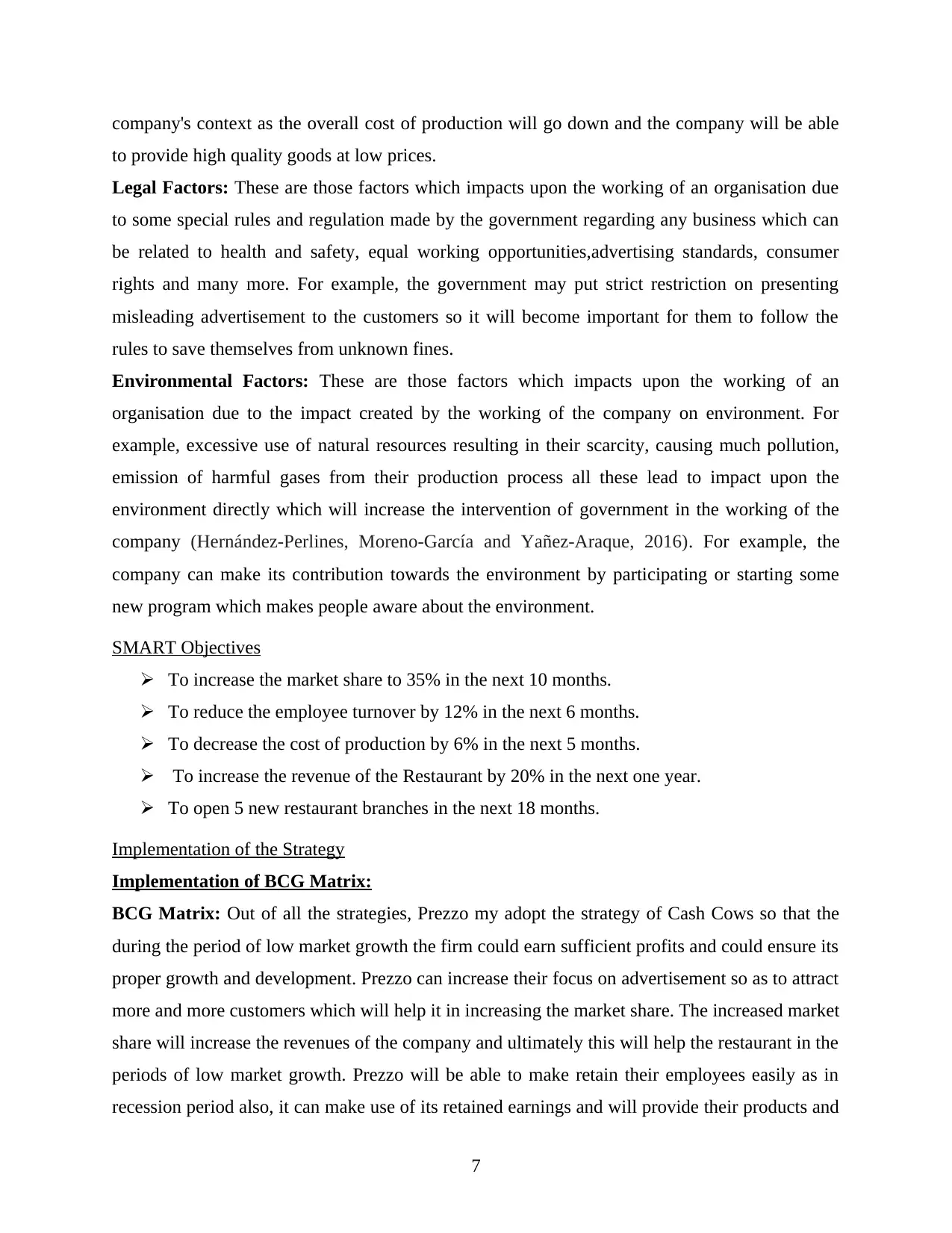
company's context as the overall cost of production will go down and the company will be able
to provide high quality goods at low prices.
Legal Factors: These are those factors which impacts upon the working of an organisation due
to some special rules and regulation made by the government regarding any business which can
be related to health and safety, equal working opportunities,advertising standards, consumer
rights and many more. For example, the government may put strict restriction on presenting
misleading advertisement to the customers so it will become important for them to follow the
rules to save themselves from unknown fines.
Environmental Factors: These are those factors which impacts upon the working of an
organisation due to the impact created by the working of the company on environment. For
example, excessive use of natural resources resulting in their scarcity, causing much pollution,
emission of harmful gases from their production process all these lead to impact upon the
environment directly which will increase the intervention of government in the working of the
company (Hernández-Perlines, Moreno-García and Yañez-Araque, 2016). For example, the
company can make its contribution towards the environment by participating or starting some
new program which makes people aware about the environment.
SMART Objectives
To increase the market share to 35% in the next 10 months.
To reduce the employee turnover by 12% in the next 6 months.
To decrease the cost of production by 6% in the next 5 months.
To increase the revenue of the Restaurant by 20% in the next one year.
To open 5 new restaurant branches in the next 18 months.
Implementation of the Strategy
Implementation of BCG Matrix:
BCG Matrix: Out of all the strategies, Prezzo my adopt the strategy of Cash Cows so that the
during the period of low market growth the firm could earn sufficient profits and could ensure its
proper growth and development. Prezzo can increase their focus on advertisement so as to attract
more and more customers which will help it in increasing the market share. The increased market
share will increase the revenues of the company and ultimately this will help the restaurant in the
periods of low market growth. Prezzo will be able to make retain their employees easily as in
recession period also, it can make use of its retained earnings and will provide their products and
7
to provide high quality goods at low prices.
Legal Factors: These are those factors which impacts upon the working of an organisation due
to some special rules and regulation made by the government regarding any business which can
be related to health and safety, equal working opportunities,advertising standards, consumer
rights and many more. For example, the government may put strict restriction on presenting
misleading advertisement to the customers so it will become important for them to follow the
rules to save themselves from unknown fines.
Environmental Factors: These are those factors which impacts upon the working of an
organisation due to the impact created by the working of the company on environment. For
example, excessive use of natural resources resulting in their scarcity, causing much pollution,
emission of harmful gases from their production process all these lead to impact upon the
environment directly which will increase the intervention of government in the working of the
company (Hernández-Perlines, Moreno-García and Yañez-Araque, 2016). For example, the
company can make its contribution towards the environment by participating or starting some
new program which makes people aware about the environment.
SMART Objectives
To increase the market share to 35% in the next 10 months.
To reduce the employee turnover by 12% in the next 6 months.
To decrease the cost of production by 6% in the next 5 months.
To increase the revenue of the Restaurant by 20% in the next one year.
To open 5 new restaurant branches in the next 18 months.
Implementation of the Strategy
Implementation of BCG Matrix:
BCG Matrix: Out of all the strategies, Prezzo my adopt the strategy of Cash Cows so that the
during the period of low market growth the firm could earn sufficient profits and could ensure its
proper growth and development. Prezzo can increase their focus on advertisement so as to attract
more and more customers which will help it in increasing the market share. The increased market
share will increase the revenues of the company and ultimately this will help the restaurant in the
periods of low market growth. Prezzo will be able to make retain their employees easily as in
recession period also, it can make use of its retained earnings and will provide their products and
7
Paraphrase This Document
Need a fresh take? Get an instant paraphrase of this document with our AI Paraphraser
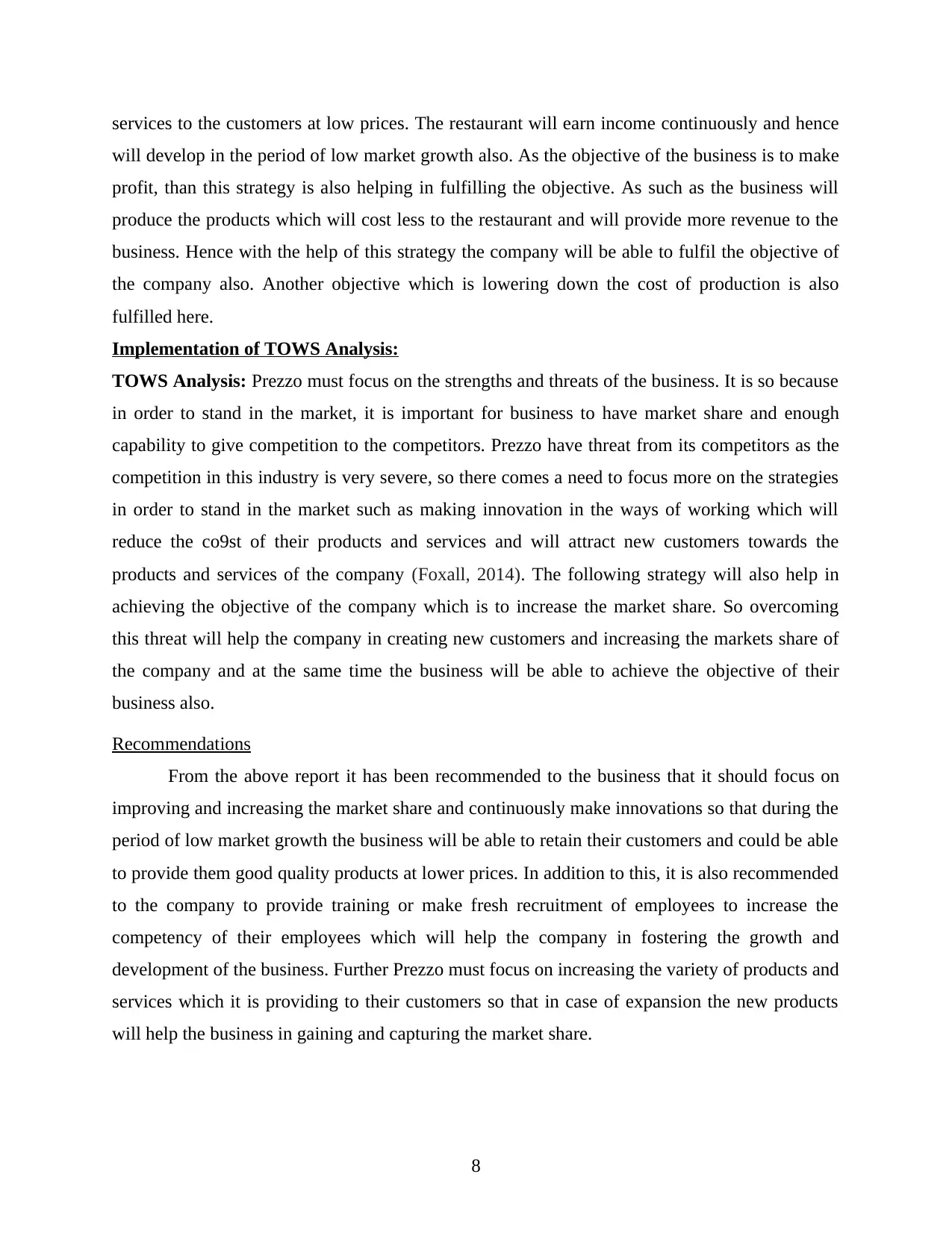
services to the customers at low prices. The restaurant will earn income continuously and hence
will develop in the period of low market growth also. As the objective of the business is to make
profit, than this strategy is also helping in fulfilling the objective. As such as the business will
produce the products which will cost less to the restaurant and will provide more revenue to the
business. Hence with the help of this strategy the company will be able to fulfil the objective of
the company also. Another objective which is lowering down the cost of production is also
fulfilled here.
Implementation of TOWS Analysis:
TOWS Analysis: Prezzo must focus on the strengths and threats of the business. It is so because
in order to stand in the market, it is important for business to have market share and enough
capability to give competition to the competitors. Prezzo have threat from its competitors as the
competition in this industry is very severe, so there comes a need to focus more on the strategies
in order to stand in the market such as making innovation in the ways of working which will
reduce the co9st of their products and services and will attract new customers towards the
products and services of the company (Foxall, 2014). The following strategy will also help in
achieving the objective of the company which is to increase the market share. So overcoming
this threat will help the company in creating new customers and increasing the markets share of
the company and at the same time the business will be able to achieve the objective of their
business also.
Recommendations
From the above report it has been recommended to the business that it should focus on
improving and increasing the market share and continuously make innovations so that during the
period of low market growth the business will be able to retain their customers and could be able
to provide them good quality products at lower prices. In addition to this, it is also recommended
to the company to provide training or make fresh recruitment of employees to increase the
competency of their employees which will help the company in fostering the growth and
development of the business. Further Prezzo must focus on increasing the variety of products and
services which it is providing to their customers so that in case of expansion the new products
will help the business in gaining and capturing the market share.
8
will develop in the period of low market growth also. As the objective of the business is to make
profit, than this strategy is also helping in fulfilling the objective. As such as the business will
produce the products which will cost less to the restaurant and will provide more revenue to the
business. Hence with the help of this strategy the company will be able to fulfil the objective of
the company also. Another objective which is lowering down the cost of production is also
fulfilled here.
Implementation of TOWS Analysis:
TOWS Analysis: Prezzo must focus on the strengths and threats of the business. It is so because
in order to stand in the market, it is important for business to have market share and enough
capability to give competition to the competitors. Prezzo have threat from its competitors as the
competition in this industry is very severe, so there comes a need to focus more on the strategies
in order to stand in the market such as making innovation in the ways of working which will
reduce the co9st of their products and services and will attract new customers towards the
products and services of the company (Foxall, 2014). The following strategy will also help in
achieving the objective of the company which is to increase the market share. So overcoming
this threat will help the company in creating new customers and increasing the markets share of
the company and at the same time the business will be able to achieve the objective of their
business also.
Recommendations
From the above report it has been recommended to the business that it should focus on
improving and increasing the market share and continuously make innovations so that during the
period of low market growth the business will be able to retain their customers and could be able
to provide them good quality products at lower prices. In addition to this, it is also recommended
to the company to provide training or make fresh recruitment of employees to increase the
competency of their employees which will help the company in fostering the growth and
development of the business. Further Prezzo must focus on increasing the variety of products and
services which it is providing to their customers so that in case of expansion the new products
will help the business in gaining and capturing the market share.
8
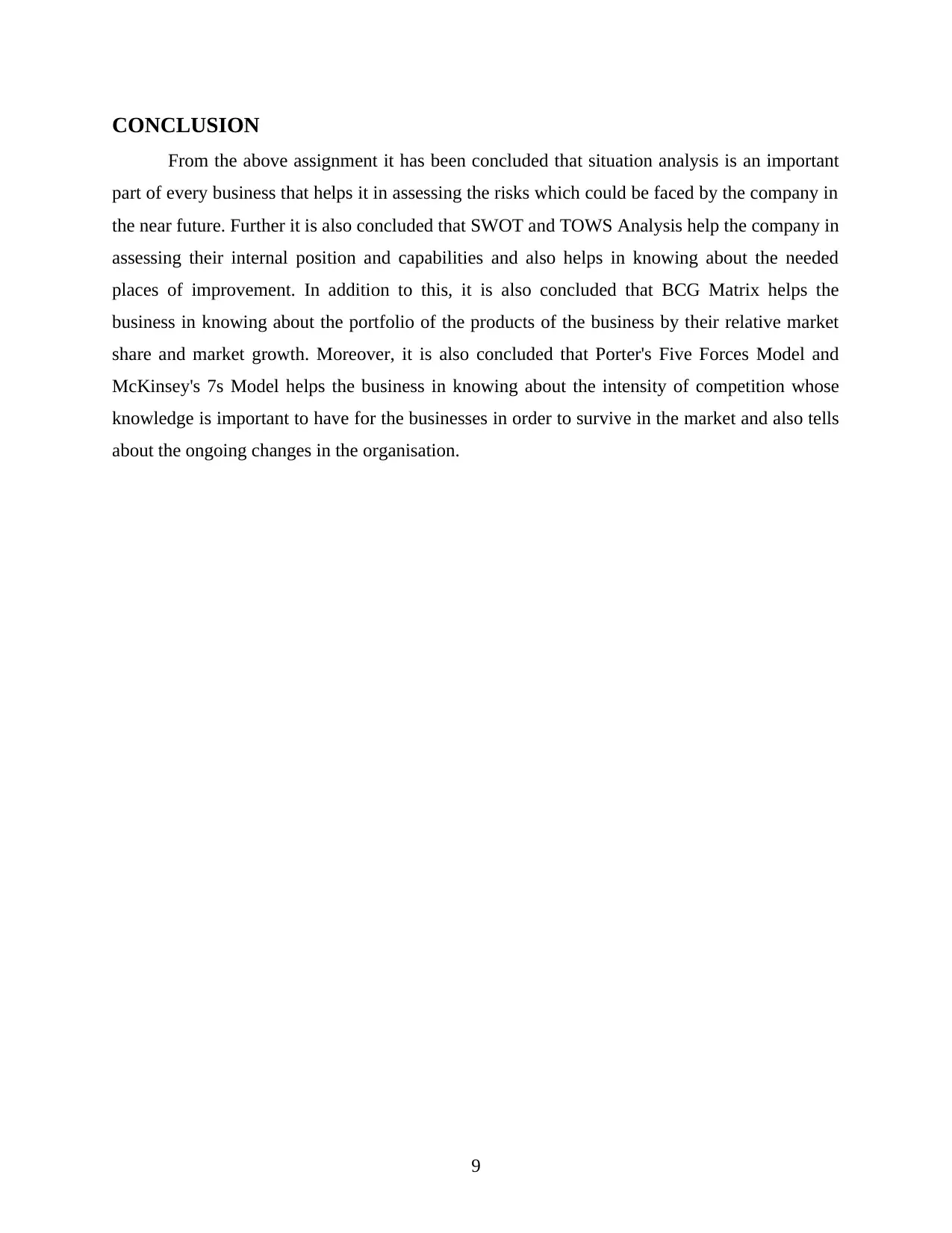
CONCLUSION
From the above assignment it has been concluded that situation analysis is an important
part of every business that helps it in assessing the risks which could be faced by the company in
the near future. Further it is also concluded that SWOT and TOWS Analysis help the company in
assessing their internal position and capabilities and also helps in knowing about the needed
places of improvement. In addition to this, it is also concluded that BCG Matrix helps the
business in knowing about the portfolio of the products of the business by their relative market
share and market growth. Moreover, it is also concluded that Porter's Five Forces Model and
McKinsey's 7s Model helps the business in knowing about the intensity of competition whose
knowledge is important to have for the businesses in order to survive in the market and also tells
about the ongoing changes in the organisation.
9
From the above assignment it has been concluded that situation analysis is an important
part of every business that helps it in assessing the risks which could be faced by the company in
the near future. Further it is also concluded that SWOT and TOWS Analysis help the company in
assessing their internal position and capabilities and also helps in knowing about the needed
places of improvement. In addition to this, it is also concluded that BCG Matrix helps the
business in knowing about the portfolio of the products of the business by their relative market
share and market growth. Moreover, it is also concluded that Porter's Five Forces Model and
McKinsey's 7s Model helps the business in knowing about the intensity of competition whose
knowledge is important to have for the businesses in order to survive in the market and also tells
about the ongoing changes in the organisation.
9
⊘ This is a preview!⊘
Do you want full access?
Subscribe today to unlock all pages.

Trusted by 1+ million students worldwide
1 out of 13
Related Documents
Your All-in-One AI-Powered Toolkit for Academic Success.
+13062052269
info@desklib.com
Available 24*7 on WhatsApp / Email
![[object Object]](/_next/static/media/star-bottom.7253800d.svg)
Unlock your academic potential
Copyright © 2020–2025 A2Z Services. All Rights Reserved. Developed and managed by ZUCOL.





